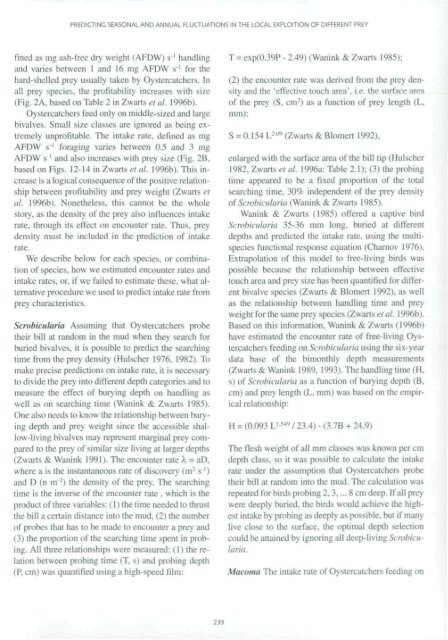waders and their estuarine food supplies - Vlaams Instituut voor de ...
waders and their estuarine food supplies - Vlaams Instituut voor de ...
waders and their estuarine food supplies - Vlaams Instituut voor de ...
You also want an ePaper? Increase the reach of your titles
YUMPU automatically turns print PDFs into web optimized ePapers that Google loves.
PREDICTING SEASONAL AND ANNUAL FLUCTUATIONS IN THE LOCAL EXPLOITION OF DIFFERENT PREY<br />
lined as mg ash-free dry weight (AFDW) s ' h<strong>and</strong>ling<br />
<strong>and</strong> varies between I <strong>and</strong> 16 mg AFDW s" 1 for the<br />
hard-shelled prey usually taken by Oystercatchers. In<br />
all prey specie-, the piofitabffiQ increases with<br />
(Fig. 2A. based on Table 2 in Zwarts el al. 1996b).<br />
Oystercatchers feed only on middle-sized <strong>and</strong> large<br />
bivalves. Small si/e classes are ignored as being extremely<br />
unprofitable. The intake rate, <strong>de</strong>fined as mg<br />
AFDW s ' foraging varies between 0.5 <strong>and</strong> 3 mg<br />
AFDW s ' <strong>and</strong> also increases wilh prey size (Fig. 2B.<br />
based on Figs. 12-14 in Zwarts et al. 1996b). This increase<br />
is a logical consequence of the positive relationship<br />
between profitability <strong>and</strong> prey weight (Zwarts et<br />
al. 1996b). Nonetheless, this cannot be the whole<br />
story, as the <strong>de</strong>nsity of the prey also influences intake<br />
rate, through its effect on encounter rate. Thus, prey<br />
<strong>de</strong>nsity must be inclu<strong>de</strong>d in the prediction of intake<br />
rale.<br />
We <strong>de</strong>scribe below for each species, or combination<br />
of species, how we estimated encounter rates <strong>and</strong><br />
intake rates, or. if we failed to estimate these, whai alternative<br />
procedure we used to predict intake rate from<br />
prey characteristics.<br />
Scrobicularia Assuming that Oystercatchers probe<br />
<strong>their</strong> bill at r<strong>and</strong>om in the mud when they search for<br />
buried bivalves, it is possible to predict the searching<br />
lime from the prey <strong>de</strong>nsity (Hulseher 1976. 1982). To<br />
make precise predictions on intake rate, ii is necessary<br />
to divi<strong>de</strong> the prey into different <strong>de</strong>pth categories <strong>and</strong> lo<br />
measure the effect of burying <strong>de</strong>pth on h<strong>and</strong>ling as<br />
well as on searching time (Wanink & Zwarts 1985).<br />
One also needs lo know the relationship between burying<br />
<strong>de</strong>pth <strong>and</strong> prey weight since the accessible shallow-living<br />
bivalves may represent marginal prey compared<br />
to the prey of similar size living at larger <strong>de</strong>pths<br />
(Zwarts & Wanink 1991). The encounter rate X = aD.<br />
where a is the instantaneous rate ol discovery (m 2 s 1 )<br />
<strong>and</strong> D (n m 2 ) the <strong>de</strong>nsity of the prey. The searching<br />
time is the inverse of the encounter rate . which is the<br />
product of three variables: 11) the time nee<strong>de</strong>d to thrust<br />
the bill a certain distance into the mud. (2) the number<br />
of probes that has to be ma<strong>de</strong> to encounter a prey <strong>and</strong><br />
(3) the proportion of the searching time spent in probing.<br />
All three relationships were measured: (11 the relation<br />
between probing time (T. s) <strong>and</strong> probing <strong>de</strong>pth<br />
i P. cm) was quantified using a high-speed film:<br />
239<br />
T = exp(0.39P - 2.49) (Wanink & Zwarts 1985):<br />
(2) the encounter rate was <strong>de</strong>rived from the prey <strong>de</strong>n-<br />
-!!) <strong>and</strong> the 'effective touch area', i.e. th.* saitface area<br />
of the prey (S. cm 2 ) as a function of pre) length (L.<br />
mm):<br />
S = 0.154 L 2 - 09 (Zwarts & Blomert 1992).<br />
enlarged with the surface area of the bill tip (Hulscher<br />
1982, Zwarts et al. 1996a: Table 2.1); (3) the probing<br />
time appeared to be a fixed proportion of ihe total<br />
searching time. 30'? in<strong>de</strong>pen<strong>de</strong>nt of the prey <strong>de</strong>nsity<br />
of Scrobicularia i Wanink & Zwarts 1985).<br />
Wanink & Zwarts (1985) offered a captive bird<br />
Scrobicularia 35-36 mm long, buried al different<br />
<strong>de</strong>pths <strong>and</strong> predicted the intake rate, using the multispecies<br />
functional response equalion (Charnov 1976).<br />
Extrapolation of this mo<strong>de</strong>l to free-living birds was<br />
possible because the relationship between effective<br />
touch area <strong>and</strong> prey size has been quantified for different<br />
bivalve species (Zwarts & Blomert 1992). as well<br />
as the relationship between h<strong>and</strong>ling time <strong>and</strong> prey<br />
weight for the same prey species (Zw at is et al. 1996b).<br />
Based on this information. Wanink & Zwarts (1996b)<br />
have estimated the encounter rate of free-living Oystercatchers<br />
feeding on Scrobicularia using the six-year<br />
data base of the bimonthly <strong>de</strong>pth measurements<br />
(Zwarts & Wanink 1989, 1993). The h<strong>and</strong>ling time (II.<br />
s) n\ Scrobicularia as a function of burying <strong>de</strong>pth (B.<br />
cm) <strong>and</strong> prev lengih (L. mm) was based on the empirical<br />
relationship:<br />
H = (0.093 L 1549 /23.4) - (3.7B + 24.9)<br />
The flesh weight of all mm classes was known |>er cm<br />
<strong>de</strong>pth class, so it was possible to calculate the iniake<br />
rate tin<strong>de</strong>r the assumption lhat Oystercalchers probe<br />
<strong>their</strong> bill at r<strong>and</strong>om into the mud. The calculation was<br />
repeated for birds probing 2,3,... 8 cm <strong>de</strong>ep. If all prey<br />
were <strong>de</strong>eply buried, the birds would achieve the highest<br />
intake by probing as <strong>de</strong>eply as possible, bin if man)<br />
live close to the surface, the optimal <strong>de</strong>pth seleciion<br />
could be attained by ignoring all <strong>de</strong>ep-living Scrobicularia.<br />
Macoma The intake rate of Ov stercatchers feeding on

















